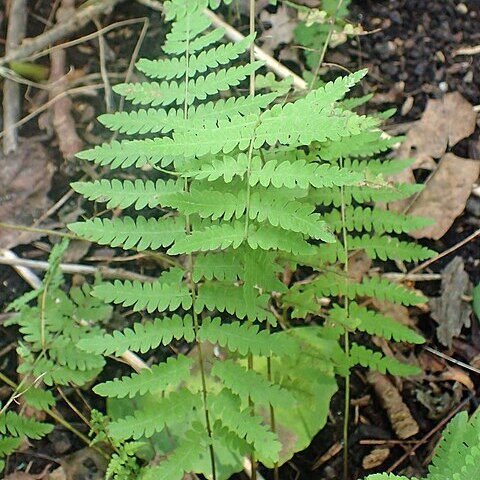Rhizome wide-creeping, irregularly branched, up to 2.2 mm in diam., with stipe bases up to 70 mm apart and scales; scales castaneous, ovate to broadly ovate, up to 2.2 x 1.3 mm. Fronds erect, up to 950 mm long. Stipe basally castaneous, stramineous higher up, shallowly sulcate adaxially, up to 465 mm long, up to 2.5 mm in diam., sparsely set with scales similar to those on rhizome, closely set with pale unicellular acicular hairs. Lamina 1-pinnate-pinnatifid, narrow-elliptic to oblong-cuneate, up to 385 x 175 mm, basal pinnae not or slightly reduced. Pinnae petiolate, herbaceous, proximally more widely spaced, linear-cuneate, up to 100 x 17 mm, pinnatifid; lobes oblong-obtuse to oblong-acute, up to 9 x 4 mm, entire, adaxially with unicellular acicular hairs along costa and veins, and scales along costa, scales pale brown, lanceolate to ovate, up to 1.5 x 0.5 mm, abaxially with glands, hairs and scales, glands occur along and between veins, hairs occur along costa, veins and lamina margins, scales broadly ovate, up to 1.2 x 1 mm, occurring along costa and veins; venation evident, vein branches forked, simple near lobe apex. Sori circular, up to 1 mm in diam. Indusium stramineous, reniform to irregularly shaped, with obovate and acicular hairs along margin and surface; receptacle nude.
Rhizome slender, c. 2.5-4 mm diam., extremely tough and flexible. Frond to 1 m tall, but frequently much less, bright lime-green. Stipe 15-50 cm long. Lamina 25-50 cm long; sterile pinnae commonly 4-6 cm long, to 1.5 cm wide; fertile pinnae ±same length but 6-11 mm wide; basal pinnae slightly reduced, with elongate and sometimes free basal lobes; middle pinnae not dilated at their bases, lobed to less than 1 mm from costa; lobe margins strongly recurved, giving the lobes the appearance of being much narrower than the sterile ones; veins in sterile pinnae mostly forked, in fertile pinnae often simple; lower surface of costae with slender hairs and flat ovate-rounded ciliate scales 0.5-l mm long and wide; lower surface between veins with a variable number of slender acicular and short-capitate hairs. Sori indusiate, nearer to costules than to margin; indusium reniform, bearing glandular hairs.
Rhizome 2 mm diameter; stipe stramineous, 15-50 cm long; lamina 25-50 cm long, pinnae to 20 or more pairs, dimorphous; sterile pinnae to 15 mm or more wide, fertile commonly 6-9 mm wide; lowest pinnae slightly reduced, sometimes with free basal acroscopic segment; middle pinnae not dilated at base, lobed to less than 1 mm from costa; veins in sterile fronds mostly forked, in fertile sometimes simple; lower surface of costae bearing slender hairs and ovate-orbicular flat scales with short hairs on edges; lower surface of lamina bearing a variable number of slender acicular and/or short capitate hairs; upper surface short-hairy on costa. Sori near costules; indusia bearing short hairs on edges.
Rhizome 2 mm diameter (dry). Stipe stramineous, 15-50 cm long. Lamina 25-50 cm long; pinnae to 20 pairs or more, dimorphous. Sterile pinnae commonly 4-6 x 1.5 cm, fertile 6-9 mm wide; lowest pinnae slightly reduced, sometimes with a free basal acroscopic lobe; middle pinnae not dilated at base, lobed to less than 1 mm from costa; veins in sterile fronds mostly forked, in fertile often simple; lower surface of costae bearing slender hairs and ovate-orbicular flat ciliate scales 0.5-1 mm long and wide; lower surface between veins bearing a variable number of slender acicular and short capitate hairs; hairs on upper surface of costa short. Sori near costules; indusia with short marginal hairs.
Rhizome widely creeping, set with dark brown, ovate, somewhat undulate rhizome-scales up to 2 mm long, becoming black and subglabrous with age. Fronds spaced up to 50 mm apart, erect, very firmly herbaceous, non-proliferous; stipe pale brown for most of its length, glabrous, up to 0.45 m long; lamina lanceolate to broadly lanceolate, up to 0.5 x 0.21 m, apex acute, deeply bipinnatifid, basal pinnae slightly reduced; pinnae very oblong-lanceolate, acute, deeply pinnatifid; costa set with pale brown ovate scales below, glandular or thinly pilose. Sori circular, up to 18 per lobe, medial; indusium glabrous, up to 0.5 mm in diameter.
Rhizome widely creeping, set with dark brown rhizome scales. Lamina lanceolate, up to 0.50 x 0.21 m, deeply bipinnatifid. Pinnae oblong-lanceolate, deeply pinnatifid. Ovate scales borne along lower surface of costae. Sori circular, medial.
Perennial with widely spreading rhizome. Fronds erect, soft, 2-pinnatifid, stipe glabrous, lamina lanceolate, pinnae deeply pinnatifid, costa scaled or thinly pilose. Null Sori circular, to 18 per lobe, medial, indusium glabrous.


